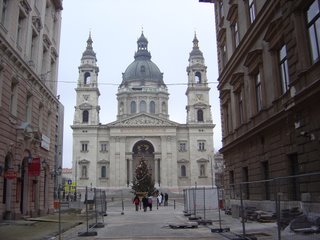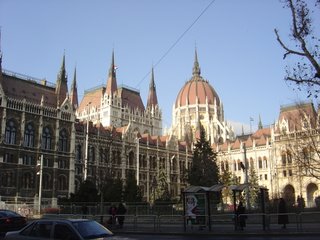Budapest IV -- Buildings
 We've already mentioned the Palace, which is probably Budapest's most prominent building, sitting, as it does, atop a hill right on the bank of the Danube. It's immense and very imposing and, as already reported, contains two important museums, including the Hungarian National Gallery.
We've already mentioned the Palace, which is probably Budapest's most prominent building, sitting, as it does, atop a hill right on the bank of the Danube. It's immense and very imposing and, as already reported, contains two important museums, including the Hungarian National Gallery.However, the city is properly proud of a number of other buildings that are imposing, beautiful and, in some cases, quite large. The Parliament building was fully opened in 1902, after decades of construction. It's in the neo-Gothic style, the same style as Britain's Parliament on the banks of the Thames in London
 and, in fact, it is widely acknowledged to have been inspired by the British version. At the time of its construcion it was the largest Parliament building in Europe. It was actually dedicated in 1896 -- the thousand-year anniversary of the founding of the Hungarian nation, when only the central portion was actually ready for occupancy. The two wings were completed six years later. At the time of its completion, Hungary had a two-house Parliament, with an
and, in fact, it is widely acknowledged to have been inspired by the British version. At the time of its construcion it was the largest Parliament building in Europe. It was actually dedicated in 1896 -- the thousand-year anniversary of the founding of the Hungarian nation, when only the central portion was actually ready for occupancy. The two wings were completed six years later. At the time of its completion, Hungary had a two-house Parliament, with an upper and lower chamber, so the building is completely symmetrical about the center portion, with an identical wing for each chamber. However, in 1944 Hungary changed its government to include a single house of Parliament, so the upper chamber's wing is no longer used. This works well, as it is the wing that tourists are shown, since it is identical to the wing actually used.
upper and lower chamber, so the building is completely symmetrical about the center portion, with an identical wing for each chamber. However, in 1944 Hungary changed its government to include a single house of Parliament, so the upper chamber's wing is no longer used. This works well, as it is the wing that tourists are shown, since it is identical to the wing actually used.The main entrance and stairwell are spectacular, showcasing all-Hungarian construction materials and skills -- with the exception of 8 granite pillars donated by the King of Sweden. Gold leaf abounds. The staircase leads to a grand Domed Hall, with 16 pillars supporting the dome, each adorned with the coat of arms and a statue of a significant Hungarian ruler. The Hall is also the home of the country's most precious treasure, the crown of St. Stephen, the first Christian king of Hungary.
Another building we'd like to highlight is St. Stephen's Basilica. This, too, is a building of great beauty with more fantastic marble of a variety of colors, with soarin
 g vaults, again with "acres" of gold leaf and with beautiful altars. Unfortunately, we visited this great church at twilight and, even with the flash (which, amazingly, was permitted) we were unable to get any decent photos. The basilica, too, has an impressive dome. An interesting fact is that the dome of the basilica and the dome of the Parliament building are the two highest structures in Budapest and no building may be built that would be higher. Also interesting is that in each case the height is 96 meters -- again recalling the founding of Hungary in 896. These two buildings represent an interesting juxtaposition of Church and State in this predominantly Catholic country.
g vaults, again with "acres" of gold leaf and with beautiful altars. Unfortunately, we visited this great church at twilight and, even with the flash (which, amazingly, was permitted) we were unable to get any decent photos. The basilica, too, has an impressive dome. An interesting fact is that the dome of the basilica and the dome of the Parliament building are the two highest structures in Budapest and no building may be built that would be higher. Also interesting is that in each case the height is 96 meters -- again recalling the founding of Hungary in 896. These two buildings represent an interesting juxtaposition of Church and State in this predominantly Catholic country.The third building we want to highlight here is the Great Synagogue of Budapest -- the largest and most spectacular in Europe. It's in the Byzantine style, was built between 1854 and '59 and c
 an hold 3000 people. Since the 1930's it has also housed a museum of Judaica which now includes memorabilia of the Hitlerian Holocaust. Here we were able to get some good pictures. Kathi had never been in a synagogue before and the only one Chuck had been in is the small one in Newport, R.I., that is, if memory serves correctly, the first in the United States. One of the things that struck us w
an hold 3000 people. Since the 1930's it has also housed a museum of Judaica which now includes memorabilia of the Hitlerian Holocaust. Here we were able to get some good pictures. Kathi had never been in a synagogue before and the only one Chuck had been in is the small one in Newport, R.I., that is, if memory serves correctly, the first in the United States. One of the things that struck us w as the great beauty of the building -- beauty in a different tradition than we are used to from our visits to so many churches. The other thing was the numerous memorial tablets and other memorials of victims of the Holocaust. Though they were written in Hungarian, which neither of us could make much of, there were those horrible words that we all know that kept repeating themselves -- words like Dachau and Bergen-Belsen and Treblinka and Auschwitz. In 1935 there were about 201,000 Jews in Budapest -- in 1946 the number was about 96,000. It is a most unsettling feeling to be awed by the beauty of this synagogue while, at the same time, being reminded of this most ugly period of history.
as the great beauty of the building -- beauty in a different tradition than we are used to from our visits to so many churches. The other thing was the numerous memorial tablets and other memorials of victims of the Holocaust. Though they were written in Hungarian, which neither of us could make much of, there were those horrible words that we all know that kept repeating themselves -- words like Dachau and Bergen-Belsen and Treblinka and Auschwitz. In 1935 there were about 201,000 Jews in Budapest -- in 1946 the number was about 96,000. It is a most unsettling feeling to be awed by the beauty of this synagogue while, at the same time, being reminded of this most ugly period of history.


 a large collection of historical documents as well as artifacts. We spent too much time in the Gallery to permit visiting this museum -- it will have to be saved for our next visit. The Ethnographic museum, located next to the beautiful Parliament building was something of a disappointment, though it did have a fascinating temporary exhibit on plastics -- their history, manufacture and use. Our disappointment was probably due more to the fact that it was the only place where we encountered unhelpful staff and that we were very hungry and the museum cafe was closed for unexplained reasons.
a large collection of historical documents as well as artifacts. We spent too much time in the Gallery to permit visiting this museum -- it will have to be saved for our next visit. The Ethnographic museum, located next to the beautiful Parliament building was something of a disappointment, though it did have a fascinating temporary exhibit on plastics -- their history, manufacture and use. Our disappointment was probably due more to the fact that it was the only place where we encountered unhelpful staff and that we were very hungry and the museum cafe was closed for unexplained reasons. 



